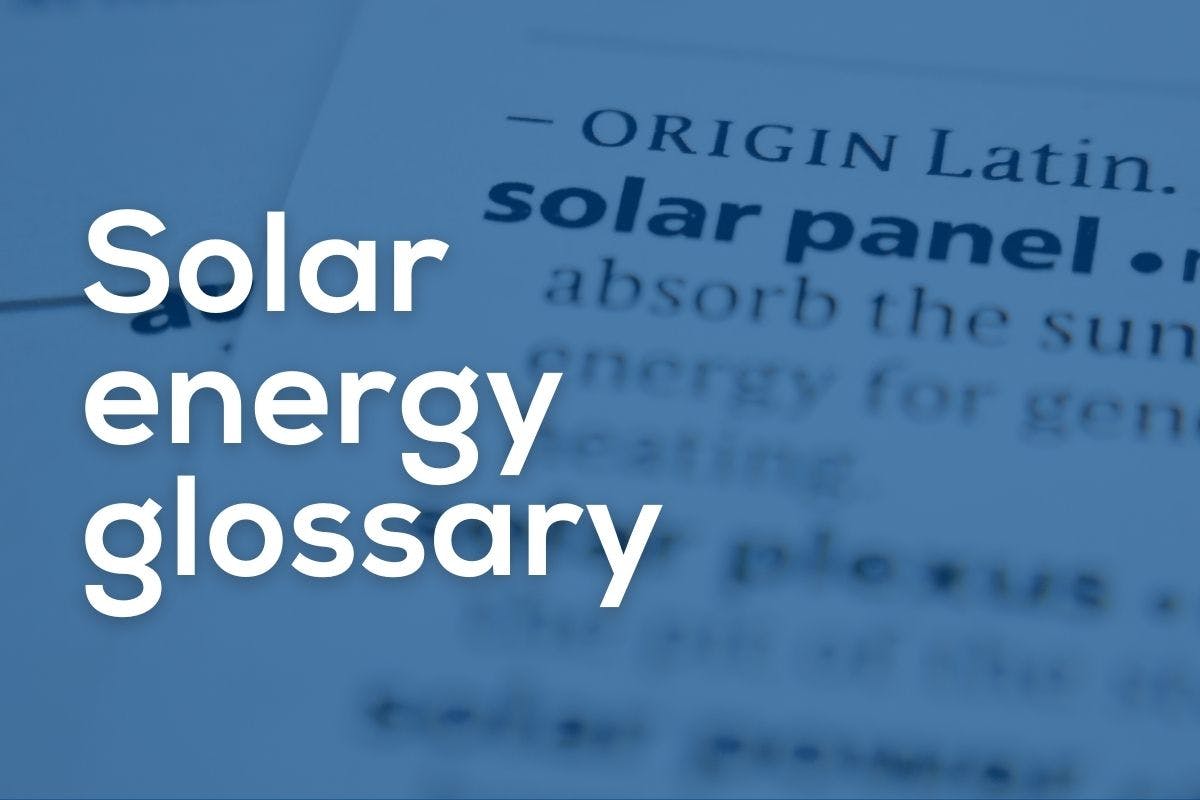Every day, Palmetto works to find the best possible solar solutions for homeowners across the country, which often includes explaining terminology that may be new to first-time adopters.
In our mission to make sustainability as simple as possible, we understand that to know exactly how solar energy works, certain words, acronyms, and concepts need to be introduced and explained in as simple terms as possible.
So to assist in your initial research or help prepare for your next solar energy assessment, below, we will define all of the key terms, jargon, and terminology that you should be familiar with when going solar today.
Glossary | Solar Lingo to Know
- Array: A term rooted in mathematics, an array is the most common word used for a grouping of solar panels. You may find an array of solar panels on a rooftop, in an open field, or even floating on a body of water.
- Bill Credit: Bill credits are reductions in utility energy spending thanks to solar power generation. Once solar panels send excess electricity to the grid, bill credits appear as line items on monthly utility statements, and may be labeled as “exports,” “power generated,” “energy produced,” or something similar.
- Circuit Breaker: On your home’s main electric service panel (see below), circuit breakers protect your system from fires or damage that would be caused by overcurrents. As an important safety measure, solar energy systems are also installed with circuit breakers and a ”DC disconnect switch” that can instantly turn solar panels off when necessary.
- Community Solar: Community solar programs allow multiple individuals to benefit from a single solar energy installation. Popular among those who rent or cannot effectively host solar panels on their property, community solar members can virtually purchase renewable energy through several different financing and membership structures.
- Critter Guard: Much like how the brands Kleenex and Band-Aid have become synonymous with tissues and bandages, Critter Guard is a popular brand of protective material used in solar installations. Products like Critter Guard block access to the space beneath solar panels from “critters” like birds and squirrels, preventing nesting, wire damage, and other complications as an essential solar pest protection service.
- Efficiency: Efficiency in solar energy can be related to several different steps of the solar power production process. Primarily, solar panel efficiency is a measure of how well a solar panel can convert sunlight into electricity. Separately, the performance of a full solar power system can also be measured using several efficiency metrics.
- Grid-Tied: A grid-tied solar energy system (also known as a grid-tie, on-grid, or utility-interactive) is by definition, one that is connected to the utility grid. Most solar panels installed on homes in the United States are grid-tied unless the property is located “off of the grid” where utility electricity services are unavailable.
- Ground-Mounted Solar: As opposed to rooftop solar panels, ground-mounted solar panels are installed on the ground, raised, and tilted at an angle to best capture sunlight. Technically speaking, carports and solar panels above parking lots can also be considered ground-mounted systems.
- Electric Panel: An electric panel (also known as a service panel, distribution board, or breaker) is a metal box that is most likely located in your basement or another lesser-trafficked part of your home. As the hub for your home’s electricity, both grid and solar-generated power travel through your electric panel.
- Energy Audit: An energy audit is an assessment of your home's energy consumption and efficiency. When performed by a professional, an energy audit will provide a full analysis of how your home uses power, including opportunities to increase energy efficiency with lighting, appliances, insulation, or other solutions.
- Inflation Reduction Act (IRA): The Inflation Reduction Act of 2022 expanded access to renewable energy in the United States in many ways. Critically, the IRA extended the longstanding investment tax credit (ITC) for homeowners going solar, now available for up to 30% of total project costs through the year 2032.
- Inverter: Besides the panels themselves, an inverter is perhaps the second-most important element of a home solar energy installation. Used to convert new DC solar power into usable AC electricity, today’s home inverters usually come in two forms: a string inverter or many microinverters (you’ll find both of these terms outlined in this glossary).
- Investment Tax Credit (ITC): Extended by the Inflation Reduction Act, solar buyers can earn an investment tax credit (ITC) after purchasing a qualifying residential renewable energy system. Officially, the incentive is known as the Residential Renewable Energy Tax Credit and has been one of the most influential programs in the growth of dispersed solar energy across the United States.
- Kilowatt (kW): A kilowatt is a unit of energy that is equal to 1,000 watts. Most electrical equipment is rated in watts, including refrigerators, microwaves, and solar panels. Referring to the total wattage of all of the installed panels, most solar energy systems are rated in kilowatts.
- Kilowatt-hour (kWh): A kilowatt-hour is a measurement of electricity usage, specifically one kilowatt of energy over one hour (60 minutes). Much like how your energy bill is calculated using kilowatt-hours, the amount of electricity produced by your solar panels is also measured in KWh.
- Microinverter: An alternative to a central string inverter, microinverters are used to convert the power generated by individual solar panels one at a time. Microinverters are typically located on the undersides of solar panels and offer homeowners several pros and cons when compared to string inverters.
- Net Billing: Like net energy metering, net billing (or a net billing tariff) is a utility agreement that credits homeowners for excess solar energy production. In 2023, a net billing structure was introduced in California, which is commonly referred to as NEM 3.0.
- Net Energy Metering (NEM): Net energy metering is a utility billing mechanism that credits solar energy producers for the electricity they share with the grid. Home solar net metering policies vary greatly by state and utility, but overall, NEM has been recognized as one of the leading initiatives responsible for increasing solar capacity in the US.
- Peak Sun Hours (PSH): Peak sun hours represent the time in the day in which sunlight conditions are optimal for solar panels to generate electricity. From the late morning to mid-afternoon, peak sun hours vary by region and season and generally fall between 3 and 6 hours per day.
- Performance-Based Incentive (PBI): A performance-based incentive is a type of financial incentive that can be earned based on the production or performance of a solar energy system. Typically offered by utilities (and increasing in popularity with battery storage), PBIs are notably different from most other solar credits and incentives in which homeowners may qualify upfront.
- Solar Battery: In a home energy system, a solar battery can be used to store electricity for later use, such as overnight or during a local electrical outage. Capable of increasing your utility savings and energy independence, solar battery storage has been becoming more and more popular in the 2020s largely thanks to lowered adoption costs and qualification for tax credits and special programs.
- Off-Grid: An off-grid solar energy system is one that is completely independent of utility connection, such as deep in the woods, on a boat, or powering your tool shed separately from your home. With a solar battery backup, grid-connected homes can temporarily shift “off of the grid” to run solely on panel-generated power.
- Palmetto: Palmetto is a company on a mission to rapidly expand residential solar energy access across the United States. We’ve been in business for over 13 years, hold an A+ Rating with the Better Business Bureau, and have served thousands of clients across 25 states.
- Photovoltaic (PV): Photovoltaic is a term used to describe any technology capable of converting sunlight into electricity. Today most of the solar energy systems you see on roofs are photovoltaic and classified as either monocrystalline or polycrystalline (black vs blue solar panels).
- Solar Ownership: As the most popular method of home solar energy adoption in the US, solar ownership represents an outright equipment purchase through either cash or a loan. When you buy or finance solar panels to achieve solar ownership, you can increase the value of your home and lower your energy bills with several different payment options.
- Solar Lease: Like an apartment or car, leasing solar allows you to benefit from a renewable energy installation without having to personally invest in all of the equipment. An alternative to solar ownership, leasing may allow you to start saving immediately through a true solar lease or a power purchase agreement (PPA).
- Solar Shingles: As a relatively new alternative to rigid solar panels, solar shingles convert sunlight into electricity while maintaining the shape, size, and aesthetic of traditional roofing materials. Solar shingles can be classified as building integrated photovoltaics (BIPV), with popular brands like the Tesla Solar Roof piquing customer interest within the last five years.
- String Inverter: Commonly used in solar energy systems across the US, a string inverter is a piece of hardware that centralizes the direct current (DC) generated by one or several “strings” of multiple solar panels. The purpose of a string inverter is to convert solar power into alternating current (AC), the form of electricity used in homes and across the power grid.
- Time-of-Use (TOU) Rates: Time of use (TOU) rates are a key part of demand-based energy pricing structures, in which the cost of electricity is tied to the time of day, week, and year it is consumed. Within a TOU rate structure, a typical day is divided into “on-peak” and “off-peak” hours, with higher and lower prices for electricity, respectively. TOU rate structures may also affect the value of solar bill credits, depending on when the energy was produced and sent to the grid.
Have more questions about solar energy?
Feel free to explore all of our solar energy resources or contact Palmetto Solar today. No matter what stage of your solar journey you may find yourself on, Palmetto is here to help!

